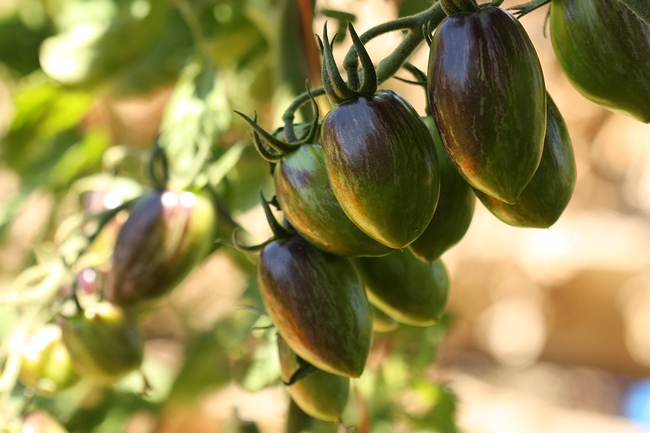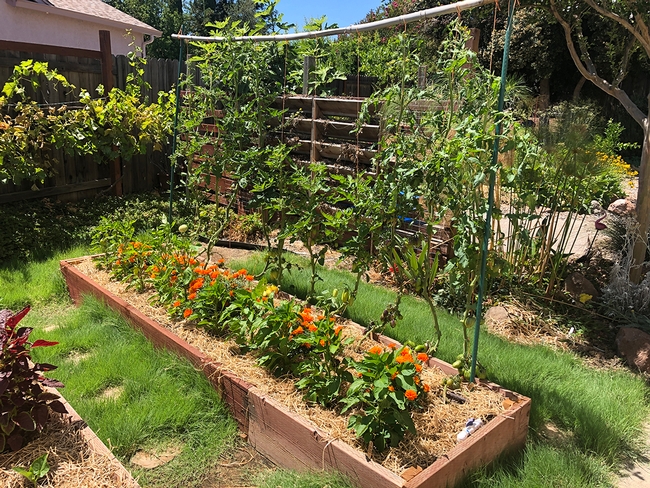Lessons from Four Summers Growing Tomatoes
I think I finally figured out how to grow tomatoes.
This is my fourth year growing tomatoes in the backyard, and two months into the season it feels like the first time I'm having real success. It's not that the first three seasons were complete failures, though at times it felt that way. It's that I look at this year's plants and how they're growing—and producing—and know that I never could have done this that first year.
The difference comes down to some very simple decisions, from the seed varieties I chose to how I planted them. While I'm still pretty new at gardening in general, and with tomatoes I've made a lot of mistakes. Fortunately, I've learned from some of them. The decisions I made this year have made all the difference.
Pick varieties you might love
A variety is a type of tomato, squash, melon, flower or other plant that is unique and that stays roughly the same from season to season. For tomatoes, there are literally thousands of varieties of all shapes, sizes and flavors. Online it's easy to find seeds for more varieties than almost any home gardener can grow in a lifetime.
One of the things that made my first year of gardening feel successful was finding a few winners. This is the fourth year growing Brad's Atomic Grape tomatoes from Wild Boar Farms, a small breeder and seed producer in Napa Valley. Right now, there are more than 80 Brad's Atomics ripening on five plants, and the few I've tasted so far have been incredible. A favorite from last year was the Rosella tomato, which is one of the all-time best-tasting small tomatoes.
There are lots of places to find quality tomato seeds online, and probably the best source for seeds of any kind is the Seed Savers Exchange, which is free to join. The exchange itself, which is separate from the SSE storefront, is a network of gardeners from across the country who list their own seeds for about $4 per packet. Exchange member Dale Thurber lists an incredible 2,500 varieties of seeds, most of them tomatoes.
Plan for how a tomato plant grows
My first year growing tomatoes, I planted a mix of determinate and indeterminate varieties and had no clue the difference between them. Choosing varieties that grow one way or the other will dictate a lot of other decisions on what to plant near them, the kind of tomatoes you'll get and how and when you'll harvest them.
Determinate tomatoes produce mostly berry-sized tomatoes. They grow into a bush and need caging so they don't flop all over the ground. You can grow them on the ground, but harvesting is harder that way, and bugs like earwigs are more likely to get the fruits before you do. I've read that with determinate tomato plants, the fruits all ripen at once and then the plant dies, but in that first year I was grazing ripe fruits from determinate plants all summer.
Indeterminate tomatoes grow primarily on a single leader, or stem, but they'll keep you busy with suckers, which are new leaders that grow from each node where the leaves meet the main stem. Indeterminate tomato plants keep growing all season long. If you prune the suckers, that means a single leader that keeps growing up and up. Rather than a cage, they grow best trained up a sturdy, single vertical stake or some other kind of support. Otherwise they sprawl on the ground and you'll lose a lot of fruits to bugs.
Start seeds indoors early to beat the Central Valley heat
When I started tomatoes from seed indoors in late January, I thought I was a little early. Given the early heat we've had this year, now I think it was right on time.
We need heat to get ripe tomatoes, but too much heat at the wrong time can mean no tomatoes. According to David Trinklein, an adjunct associate professor at the University of Missouri, “When daytime temperatures exceed 85 degrees F or nighttime temperatures exceed 70 degrees F, pollination suffers due to pollen becoming ‘tacky' and non-viable.” That means when the summer heat kicks in, fruits will be harder to come by.
In January, I pre-sprouted tomato seeds in moist napkins in plastic bags. I set the bags on an inexpensive heat mat to speed up the process. Most of the seeds sprouted within a few days. As soon as roots were visible, they went straight into a moist potting soil mix in a four-inch pot (barely covered under the surface), and those pots all went into clear plastic bins outside where they would get sunlight for most of the day. In Late March when I started putting them in the ground, there were more than enough plants for me to share with friends.
Build a simple trellis for indeterminate tomatoes
This year I planted only indeterminate tomatoes, and this was for two reasons. For one, I didn't want to keep harvesting bowls of berry tomatoes from a big sprawling plant that I'd have to cage. The second reason was that I had an idea for a simple overhead trellis system that's similar to what commercial growers use in greenhouses.
As soon as this year's plants were a foot tall, I planted two heavy eight-foot garden stakes at either end of the box and tied a length of salvaged bamboo across the top. Then I tied lengths of nylon twine from the bamboo to screws along the edge of the box roughly lined up with the tomato plants. This system will work for any wooden garden box. The materials, whether sturdy stakes or bamboo or steel tube or wood, don't matter as long as they are sturdy.
As the tomatoes grew, I loosely fastened the stems to the twine with Velcro tape. It could be Velcro tape or clips or plastic garden tape or twine, as long as the material doesn't cut into the growing trunk of the plant. As the plants grew taller, it was easy to simply wrap the stems around the twine. Even in Vacaville's high winds, this simple trellis system worked out fine.
Make sure tomato roots have room to grow
The biggest upside for this trellis system has been spacing. This garden box has drip irrigation with emitters spaced twelve inches apart. That's how far apart I spaced this year's tomato plants. I made sure this year not to crowd the indeterminate tomato plants too much with what is called “companion planting.”
Companion planting has some controversy, though not the kind that is likely to get you disinvited to Christmas. About companion plant lists, Linda Chalker-Scott, and extension horticulturist and associate professor at Washington State University has written, “Like horoscopes, these lists may be fun to use, but they should not be perceived or promoted as scientifically valid any more than astrology.”
At the same time, I have always noticed a lot of predatory insect activity near the marigolds, and I regularly have wasps patrolling the nearby tomato plants for aphids, which I appreciate. Plus, marigolds smell nice, and I chose a variety that grows compact enough that they won't shade out the row of pepper plants in the front of the box.
Try again
I haven't detailed irrigation (drip on a timer is best for me), or when to harvest (when it's time). No mention of fertility (completely organic has worked great), crop rotation or lots of other things that can make or break a season. When I began gardening, I had nothing but space to plant and the web for reading up on how to do it. There's a lot of information out there. For me, the proving ground has been the garden.
And even that first summer, when I had almost no experience, things turned out more or less all right. I had tomatoes, and by the end of the summer I had learned enough that I was certain I could do much better next year. It was another three summers before that turned out to be true.
This year, I'm going to have more tomatoes than I've ever had before. The biggest problem I'll have is eating them.
Comments:
Mike, curled leaves might be a sign of heat stress. In a climate like the Central Valley, shade cloth helps in the summer. It could also be an irrigation issue. You can buy a cheap soil moisture meter or poke your finger into the soil to see how deep the water reaches. See p. 8 of this UCANR article for more details: https://anrcatalog.ucanr.edu/pdf/8159.pdf.
Curled leaves also might not be a huge problem. I've got some curling leaves on a few of my plants even though they get the same watering regimen as healthier-looking plants right beside them. If there are no indications of pest or fertility problems and the fruit is coming along fine, I don't worry too much about curled leaves. I'll pull all the plants in late July anyway.




They are a drip system ,15min per day.
There some scrub oaks about 30' away and heard they may have an impact.
I rotate sights but this has happened the last two years.
Any thoughts on this ?
Posted by mike stoltz on June 25, 2022 at 1:14 PM